September , 1999

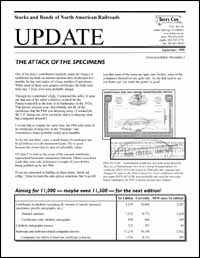
The Attack of the Specimens
One of my heavy contributors regularly sends me images of certificates he finds on internet auction sites. In the past few months, he has sent copies of a large number of specimens. While most of them were generic certificates, the bulk were truly rare. I’d say a lot were probably unique.
Through my contributor's help, I contacted the seller. It turns out that some the seller's relatives worked for the Pennsylvania RR at the time of the bankruptcy in the 1970s. That person rescued some, but certainly not all, of the certificates that the PRR was throwing away. (I worked for the U.P. during one of its cut-backs, and it is amazing what big companies discard!)
I’m told that at roughly the same time, the PRR sold some of its certificates in large lots in the “Freeman” sale. Nonetheless, many probably ended up in landfills.
So for the last thirty years, a small hoard of certificates has lived in boxes in a dry basement locale. Dry is good — because the owner had no idea of collectible values.
If you are interested in bidding on these items, check out eBay. I hope to learn the sales prices sometime, but I can tell you that some of the items are quite rare. In fact, some of the companies themselves are quite rare. As my dad used to say, you better get ‘em while the gettin’ is good.
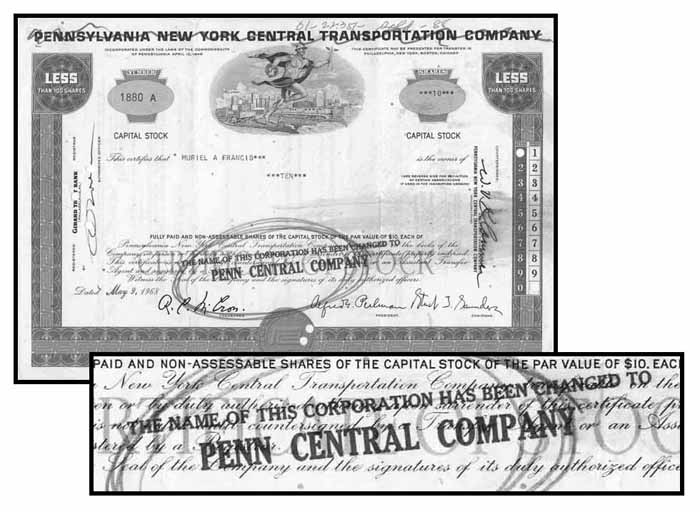 PEN-167-S-05 Transitional cerificates are some of my favorites. This was a Pennsylvania New York Central Transportation Co. certificate (PEN-535-S-60) issued in 1968 after the company had changed its name to the Penn Central Co. Later certificates with the new name (PEN-167-S-50) were probably used only for two years before bankruptcy in 1970. courtesy of Lawrence Falater.
PEN-167-S-05 Transitional cerificates are some of my favorites. This was a Pennsylvania New York Central Transportation Co. certificate (PEN-535-S-60) issued in 1968 after the company had changed its name to the Penn Central Co. Later certificates with the new name (PEN-167-S-50) were probably used only for two years before bankruptcy in 1970. courtesy of Lawrence Falater.
Aiming for 11,000 — maybe even 11,500 — for the next edition!
|
1st Edition |
Currently |
New! |
| Number of certificates listed (counting all variants of issued, specimens, etc.) |
8,559 |
10,840 |
2,281 |
| Number of distinct certificates known |
7,152 |
8,772 |
1,620 |
| Number of certificates with celebrity autographs |
699 |
848 |
149 |
| Number of celebrity autographs known |
232 |
297 |
65 |
| Number of railroads and railroad-related companies known |
17,276 |
19,198 |
1,922 |
| Number of companies for which at least one certificate is known |
3,516 |
4,111 |
595 |
Colors
By the time BNR published my book in 1995, I had decided to list the full names of colors instead of abbreviations. Over the years, though, many collectors asked for even more details about the curious colors found on certificates from companies like Fort Pitt Traction, Hudson & Manhattan, Consolidated Traction, and Omaha & Council Bluffs. For the lack of a better term, I call them combo-colors as red-orange, blue-green, and bluish gray.
Also of concern are items I originally described as being colored, when in fact, the certificates were black and white with colors confined to underprints. In response, I have gradually been correcting errors and misleading descriptions. Living up here in the mountains, however, I may never see certificates like yours in person, so please drop me a line with a photocopy as you find things you think need correcting. Better still, e-mail me a color image.
The Issue of Privacy
My goal as a writer is to convey information. But that doesn’t mean all information. The information I’m after is anything that, over the next ten, twenty, or thirty years, will help collectors enjoy the hobby. Writers live by the rule that their written words will outlive them by decades. When I take that long view, it becomes terribly obvious that I cannot afford to peddle in gossip. Gossip ages poorly.
So, if you have any kind of information that you want kept private, I give you my word that it will be kept that way. And since I won’t be around forever, and don’t know who will succeed me, I don’t even keep private information in my files. For instance, I have photocopies of certificates that people have given me with the admonition, “Don’t tell anyone where you got this!” So I don’t even write their name on the copy. Within a month or so, I can’t even come close to remembering where I got the copy.
Everything you say in confidence stays in confidence.
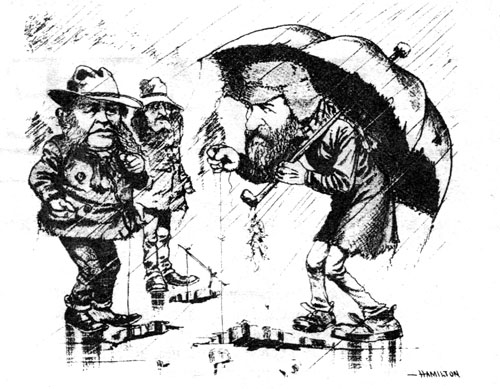 Gould catches a few suckers on this Feb 9, 1884 cover of The Judge magazine. The artwork is titled “A Cold Day on Wall Street,” reflecting The Judge’s vision that millionaires were starving during a down period on the Street. Jay Gould holds the umbrella, while William H. Vanderbilt and Daniel Drew look on forlornly. Isn’t it ironic that MKT stocks signed by Gould in the early 80s are so prolific, and yet his son, George, managed to drive the company into the ground within a few years of this cartoon.
Gould catches a few suckers on this Feb 9, 1884 cover of The Judge magazine. The artwork is titled “A Cold Day on Wall Street,” reflecting The Judge’s vision that millionaires were starving during a down period on the Street. Jay Gould holds the umbrella, while William H. Vanderbilt and Daniel Drew look on forlornly. Isn’t it ironic that MKT stocks signed by Gould in the early 80s are so prolific, and yet his son, George, managed to drive the company into the ground within a few years of this cartoon.
Generic Certificates
In the next edition, hopefully due out next June, you will see that I describe many certificates as generic. Generic certificates contain all the elements of typical custom-engraved certificates, except that they lack details such as company names, share values, and so forth. Generic certificates were used by a wide range of companies and are still sold today.
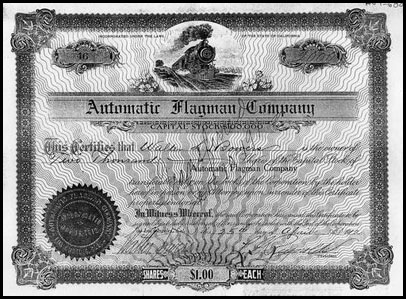 AUT-600-S-30 For those of you who collect peripheral material, here is a new one (to me) from the Automatic Flagman Co. It is a black generic certificate with a gold seal and gold sunray underprint. It was issued in Los Angeles for 5% of the company stock about a month after incorporation in 1912. Courtesy of Bob Patetta, Summit Auctions
AUT-600-S-30 For those of you who collect peripheral material, here is a new one (to me) from the Automatic Flagman Co. It is a black generic certificate with a gold seal and gold sunray underprint. It was issued in Los Angeles for 5% of the company stock about a month after incorporation in 1912. Courtesy of Bob Patetta, Summit Auctions
Generic certificates fall into two main categories. The first group consists of pre-printed certificates that companies bought from stationers and printers for a few cents apiece. Companies then filled in a few particulars such as corporate names, shareholder’s names, and share prices, and were in business. Titles on these kinds of certificates were often handwritten, although some were typewritten or mimeographed. In general, these kinds of generic certificates were temporary in nature and would have been replaced by engraved certificates if the venture proved moderately successful. In general, handwritten railroad certificates are scarce, and some are exceedingly rare. The Bergen & Dundee certificate on the next page is an example of this first kind of generic certificate with everything filled in by hand.
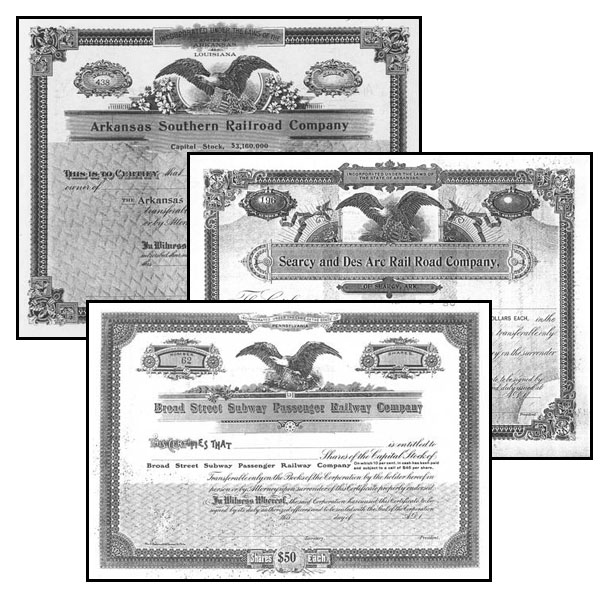 Similar generic certificates from three different printers for three different companies. Courtesy Ken Holter, Scripophily Corner.
Similar generic certificates from three different printers for three different companies. Courtesy Ken Holter, Scripophily Corner.
The second type of generic certificate is much more common. Having bought mass-produced generic certificates, companies would pay a few cents more to have their names, share prices, and maybe capital amounts printed. While the companies themselves may have been worth little more than the paper on which their certificates were printed, printed titles nonetheless made companies look more substantial.
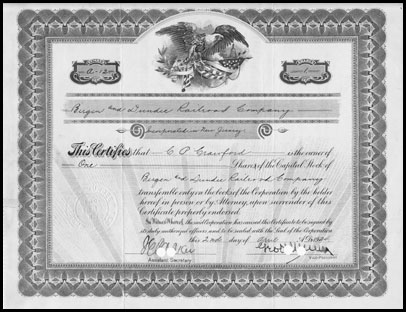 BER-103-S-40 Handwritten generic certificate from the Bergen & Dundee RR Co. dated 1920. Seventeen years later, this company was still using the same certificate, although someone in the head office had apparently purchased a typewriter by then. Courtesy Bob Patetta, Summit Auctions.
BER-103-S-40 Handwritten generic certificate from the Bergen & Dundee RR Co. dated 1920. Seventeen years later, this company was still using the same certificate, although someone in the head office had apparently purchased a typewriter by then. Courtesy Bob Patetta, Summit Auctions.
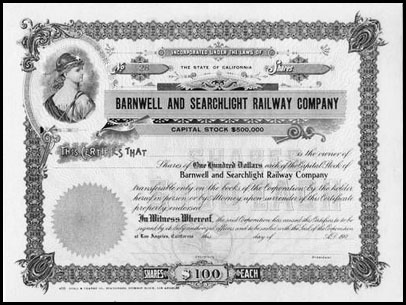 A rare generic certificate from the Barnwell & Searchlight Railway Co. with a vignette used much less commonly. This one features a very prominent sunray underprint. If you see certificates described as a “lady with star,” it is usually this vignette of an allegorical female wearing the Liberty cap. Courtesy Doug McDonald, Gypsyfoot Enterprises.
A rare generic certificate from the Barnwell & Searchlight Railway Co. with a vignette used much less commonly. This one features a very prominent sunray underprint. If you see certificates described as a “lady with star,” it is usually this vignette of an allegorical female wearing the Liberty cap. Courtesy Doug McDonald, Gypsyfoot Enterprises.
While a precious few were intaglio-printed, most generic certificates were lithographed. The typical such certificate had text and a vignette printed in black over a green or gold underprint. Some of the underprints bore a herringbone pattern, but most were a gold “sunray” pattern. Gold seals, ready for embossing with the company seal, were extremely common.
Considering the large number of printers involved in the securities trade, the number of different vignettes actually used was surprisingly small. One of the most commonly-used vignettes was of an approaching train like the one that appears on the Automatic Flagman Co. piece above. Almost as common is one with a loco leaving a tunnel left to right. Eagles were very popular subjects, as illustrated on the above three certificates. A vignette of Abraham Lincoln appeared on a few certificates, but not nearly as often as one might have expected. Another popular vignette combo was one with Liberty seated at the left and Columbia with a child and eagle seated at the right.
In every hobby that involves collectibles, beginners start with the idea that rarity equals price. Unfortunately, they’re wrong. If you follow coin prices, compare values and relative rarities of the 1804 silver dollar and the 1913 V nickel. There are lots of less showy examples in this hobby, but I don’t know of a better example than generic certificates to prove just how little price reflects rarity. Show me two equally rare certificates, and an engraved one will outsell a generic one by a dramatic margin every time. The only time their prices even approach equity is when generic certificates carry celebrity signatures. Having said that, I still don’t recall generic certificates actually equaling the prices of engraved pieces within the same time frame.
If you collect on the basis of rarity, the most affordable certificates out there are generic. On the other hand, if you collect with an eye to future value, you would probably better be served by buying engraved certificates from large, main-line railroad companies with lots of collector interest.
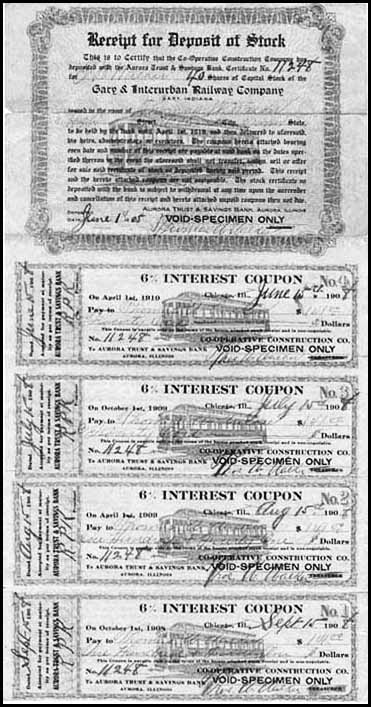
This item is stamped as a "specimen," but was completely filled out in every detail. It seems to have represented the transitional period between the Gary & Interurban “Railway” Co. and the Gary & Interurban “Railroad” Co. It looks to me that the Cooperative Construction Co. was intending to buy interest in the Railway company stock and deposit it in the Aurora Trust and Savings Bank, possibly in an effort to gain controlling interest. Dated 1905, it appears that interest would have been deferred for about three years and tacked on to the amount promised starting in 1908. Certificates from the second company are known, so the reorganization was obviously successful. This item has an interurban car in green under-print on both the certificate and the interest coupons and dates from the period of huge interurban investment prior to World War I. (This item appeared on an internet auction site.)
Gobs of New Items
Between a couple of major auction catalogs, some fixed price lists, and heavy contribution from my readers, the list of known certificates has grown by 755 in the last three months. A whopping 453 items represented completely new varieties! Almost half of those new varieties represented the first certificates known for small and short-time railroads.
The number of new railroad company discoveries, however, has tapered off. This is partly a function of my not having any time for research. On the other hand, maybe we’re finally starting to get a handle on the total number of railroads and railroad-related companies that might have existed in North America. Considering my broad definition, I think 20,000 is a good starting guess.
Many new company listings have come from research on the railroads in central and northern Mexico. I am sure a plethora of short lines existed, but left little paper evidence. A lot of what I currently know of obscure lines comes from the work of authors like Colin Bruce and Carlos Gaytan who’ve re-searched everything from paper money to tickets to stocks and bonds. There are several books on late-date Mexican railroads, but books about early roads tend to be difficult — or impossible — to locate even through the interlibrary loan system.
PLEASE, let me know if you research or collect Mexican or Central American railroads. Unlike the U.S. and Canada, it is very difficult to find reliable information about companies in that part of the world.